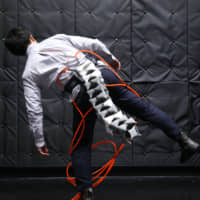Millions of years after the ancestors of humans evolved to lose their tails, researchers at Keio University have built a robotic one they say could help unsteady elderly people keep their balance.
Dubbed Arque, the gray 1-meter device mimics tails that cheetahs and other animals use to keep their balance while running and climbing, the Keio team says.
"The tail keeps balance like a pendulum," said Junichi Nabeshima, a graduate student and researcher at the university's Embodied Media Project, demonstrating the robotic device attached to his waist with a harness.
"When humans tilt their body one way, the tail moves in the opposite direction."
As Japan grays, it is leading the industrial world in seeking ways to keep its aging population mobile and productive.
While other nations have turned to immigrant workers to replenish a shrinking workforce, less-welcoming Japan has focused more on a technological solution.
Keio's robotic tail, which uses four artificial muscles and compressed air to move in eight directions, will remain in the lab for now, however, as researchers look for ways to make it more flexible, Nabeshima said.
Apart from helping the elderly get around, the team is also looking at potential industrial applications for the artificial appendage, such as a balance aid for warehouse workers carrying heavy loads.
"I think it would be nice to incorporate this further developed prosthetic tail into daily life, when one seeks a little more help balancing," Nabeshima said.


















With your current subscription plan you can comment on stories. However, before writing your first comment, please create a display name in the Profile section of your subscriber account page.